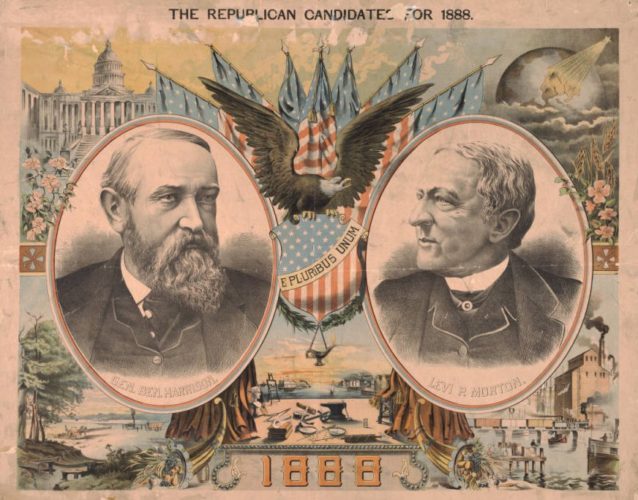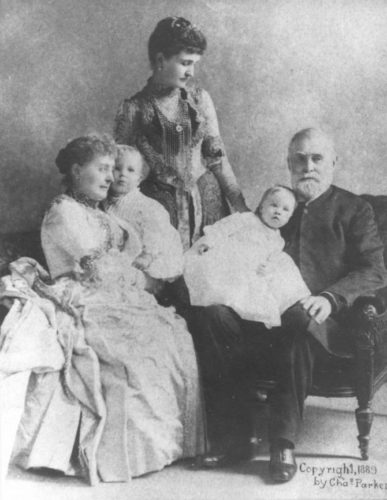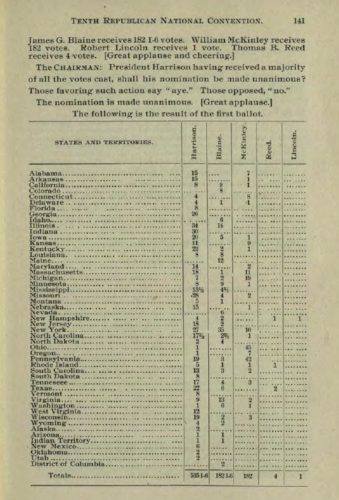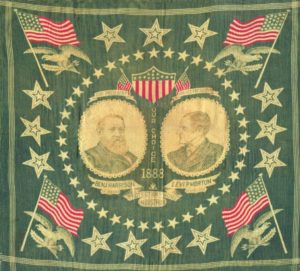Benjamin Harrison: A Presidential Legacy

Benjamin Harrison was born on August 20, 1833, in North Bend, Ohio. He came from a longtime political family: his father was a farmer who had served in Congress; his grandfather was U.S. President William Henry Harrison; and his great-grandfather was Benjamin Harrison V, a signer on the Declaration of Independence.

Harrison was initially educated at home by a tutor, but he later attended Farmer’s College prep school in Cincinnati. It was there that he first met his future wife, Caroline Scott, a professor’s daughter. When Caroline’s father moved to Oxford, Ohio, to open the Oxford Female Institute, Harrison transferred to Miami University, graduating in 1852. He then began to study law in Cincinnati and married Caroline on October 20, 1853. After finishing his studies he and Caroline moved to Indianapolis, where Harrison spent the next few years building a law practice. He joined the Republican party soon after its founding in 1856 and was elected city attorney in 1857.
In 1862, a year after the Battle of Fort Sumter, Abraham Lincoln issued a call for additional troops. Harrison recruited throughout northern Indiana. Although he initially resisted an officer position due to his lack of military experience, Indiana governor Oliver Morton commissioned him a colonel in August 1862. The newly-formed 70th Indiana was mustered into federal service that same month. For the next two years the 70th mostly performed reconnaissance and guard duty. However, in 1864 they joined William Tecumseh Sherman’s Atlanta campaign and moved to the front lines, where Harrison commanded a brigade at several battles. Harrison rose to the rank of brigadier general before mustering out of the army on June 8, 1865. He would later become the last Civil War general to serve as president.
After the war, Harrison returned to Indiana and resumed his law practice. He became increasingly well known in political circles, campaigned for other Republican candidates, and ran unsuccessfully for office. After serving as a delegate to the 1880 Republican National Convention, he was elected to the U.S. Senate, where he served from 1881-1887. Afterwards he returned to Indiana, where he stayed active in both state and national politics.

The 1888 Republican National Convention lacked a clear frontrunner for the presidential nomination. After placing fifth on the first ballot, Harrison was eventually elected the party’s presidential candidate on the eighth ballot by a vote of 544 to 108. His opponent was incumbent president Grover Cleveland. Unlike his grandfather William Henry Harrison, Benjamin ran one of the country’s first “front porch” campaigns; instead of traveling throughout the country, he gave speeches to delegations that visited him in Indianapolis. Voter turnout for the election was nearly eighty percent. Although Harrison lost the popular vote by 90,000, he won the electoral college 233 to 168.
In his inaugural address Harrison supported protective tariffs, statehood for western territories, modernization of the Navy, and pensions for Civil War veterans. He acted independently when selecting his cabinet, refusing to follow the patronage system—and angering Republican party bosses in the process.
Historians have viewed Harrison’s presidency with mixed feelings. Although Harrison supported civil rights for African Americans, none of the measures he championed (including voting rights and education) survived Congress. After his cabinet selection he did little else to actively promote civil service reform, but he did make good on his promise to support Civil War veterans with the passage of the Dependent and Disability Pension Act in 1890. The Sherman Antitrust Act (sponsored by Ohio senator John Sherman, brother of William Tecumseh Sherman) was also enacted during his presidency; it remains in effect today.

Harrison expanded and modernized the U.S. Navy, and also created the first national forest reserves. Six new states were admitted to the union during his presidency. He was also active in foreign policy: he convened the first Pan-American Conference in 1899, negotiated the U.S. protectorate of the Samoan Islands, attempted to annex Hawaii, and negotiated several reciprocal trade agreements.
Harrison’s wife Caroline made her own mark on Washington, supervising a renovation of the White House, putting up the first White House Christmas tree, and serving as the first president of the Daughters of the American Revolution. She also helped Johns Hopkins Hospital with fundraising for a new hospital wing—on the condition that the medical school would admit women. Caroline encouraged her husband to hire stenographer Alice Sanger, the first female White House staffer.
However, the Democrats increased their Congressional presence in the 1890 elections, and Harrison had alienated powerful members of his own party when making his cabinet appointments. Although he won the 1892 Republican nomination for president, there was serious opposition. The Democrats nominated former president Grover Cleveland, making the election a rematch of the previous one. Caroline died of tuberculosis not long before the election, so neither candidate campaigned vigorously. This time, Cleveland won both the popular vote and the electoral college by a wide margin.
After leaving the Oval Office, Harrison returned to his law practice in Indianapolis, became a popular public speaker, and served on the board of trustees of Purdue University. He died of pneumonia on March 13, 1901, and was buried in Indianapolis.
Thank you to Stephanie Michaels, Research and Catalog Services Librarian at theState Library of Ohio, for this week’s post!



Leave a Reply
You must be logged in to post a comment.